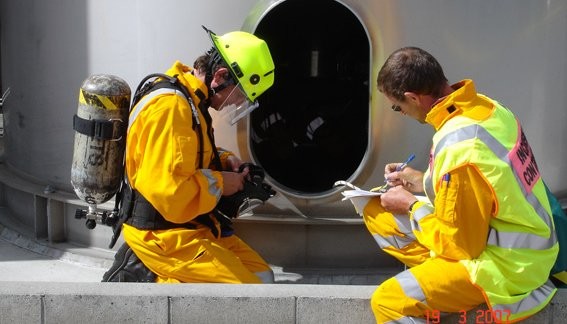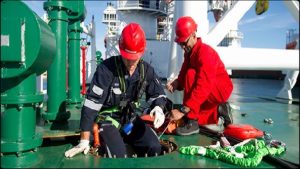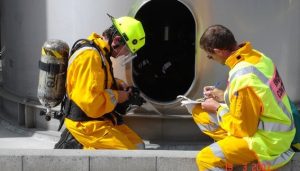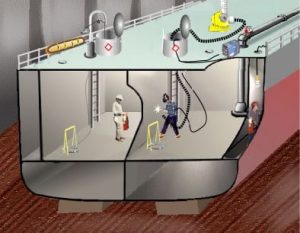Enclosed spaces onboard ships present some of the most hazardous environments in the maritime industry. These confined areas, often with limited ventilation and restricted access, can expose crew members to serious risks such as oxygen deficiency, toxic gas buildup, and even fatal accidents. Understanding the correct procedures, safety measures, and regulatory compliance is critical to ensuring the well-being of maritime professionals. Enclosed spaces on ships are defined by their limited entry and exit points, inadequate ventilation, and potential for dangerous atmospheres. Common examples include cargo holds, fuel tanks, ballast water tanks, pump rooms, and void spaces. These areas are essential for ship operations but require stringent safety protocols due to their inherent dangers.
Key Risks Associated with Enclosed Spaces
The hazards of entering enclosed spaces arise primarily from atmospheric and operational dangers:
- Oxygen Deficiency: Normal atmospheric oxygen levels are approximately 20.9%. If oxygen levels drop below 19.5%, the space is considered hazardous.
- Toxic Gas Accumulation: Gases like hydrogen sulfide (H₂S), carbon monoxide (CO), and methane (CH₄) can accumulate and cause severe health issues.
- Flammable Atmospheres: The buildup of combustible gases increases the risk of explosions.
- Physical Hazards: Limited space, unstable surfaces, and poor lighting create additional physical dangers.
Safety Regulations: SOLAS and IMO Guidelines
The International Maritime Organization (IMO) and the Safety of Life at Sea (SOLAS) convention provide a robust regulatory framework for enclosed space entry procedures. Key regulatory requirements include: SOLAS Regulation III/19: Mandates onboard drills for crew members to practice enclosed space entry and rescue operations. Furthermore, IMO Resolution A.1050(27): Offers comprehensive guidelines on safe entry procedures. Compliance with these regulations minimizes risks and enhances maritime safety culture.
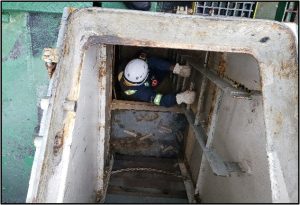
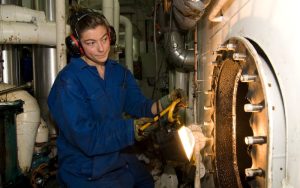
–
Entering Into An Enclosed Space on Ships
— Pre-Entry Procedures: Planning for Safety
Preparation is the cornerstone of effective safety in enclosed spaces aboard ships. Prior to entry, a structured approach is essential, including conducting risk assessments, issuing permit-to-work (PTW) documents, testing the atmosphere for hazards, ensuring proper ventilation, and establishing robust communication plans. These steps collectively minimize risks and safeguard lives during enclosed space operations.Effective safety starts with thorough preparation. Before entering an enclosed space on ships, the following steps must be completed:
- Risk Assessment: Conduct a formal risk evaluation to identify potential hazards.
- Permit-to-Work System: Issue a permit-to-work (PTW) document detailing the task, authorized personnel, and safety measures.
- Atmosphere Testing: Measure oxygen levels and detect toxic or flammable gases using calibrated gas detectors.
- Ventilation: Ensure adequate ventilation to remove hazardous gases and restore breathable air.
- Communication Plan: Establish clear communication protocols with standby personnel.
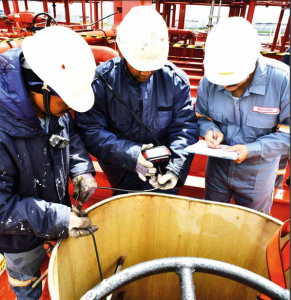
— During Enclosed Space Operations
While performing operations in an enclosed space, it is crucial to adhere to strict safety protocols to mitigate risks. Key measures include:
- Continuous Monitoring: Utilize gas detectors to continuously monitor the atmosphere for oxygen levels and the presence of toxic or flammable gases. Personnel should be equipped with personal gas monitors that provide real-time data
- Communication: Maintain constant communication between personnel inside the enclosed space and the standby team outside. This ensures that any changes in conditions or emergencies can be promptly addressed
- Emergency Preparedness: Ensure that all personnel are familiar with emergency procedures. Rescue equipment, such as self-contained breathing apparatus (SCBA) and stretchers, should be readily accessible, and a designated attendant must oversee operations from outside the space.
- Ventilation: Ensure that ventilation systems remain operational throughout the operation to provide fresh air and remove hazardous gases. Regular checks should confirm that ventilation is effective.
— After Exiting Enclosed Space Operations
Upon completion of work in an enclosed space, several important steps must be taken to ensure safety and compliance:
- Atmosphere Testing: Conduct a final atmosphere test to confirm that the space is safe for re-entry or that it remains free of hazardous conditions before sealing it off again.
- Permit Closure: Complete and close the permit-to-work documentation, ensuring all tasks have been recorded and safety checks have been performed. This documentation serves as a record of compliance with safety procedures.
- Post-Operation Review: Hold a debriefing session with all personnel involved to discuss the operation, identify any issues encountered, and recommend improvements for future operations. This review is essential for continuous safety enhancement and training purposes
- Equipment Check: Inspect all equipment used during the operation for any damage or wear. Ensure that all safety gear is cleaned, maintained, and stored properly for future use.
–
Essential Safety Equipment, Training, and Competency Development
Enclosed space entry requires specialized equipment designed for hazardous environments:
- Portable Gas Detectors: Measure oxygen levels, toxic gases, and flammable vapors.
- Personal Protective Equipment (PPE): Includes helmets, gloves, protective suits, and safety boots.
- Breathing Apparatus: Self-contained breathing apparatus (SCBA) provides clean air supply.
- Rescue Gear: Includes safety harnesses, lifelines, and rescue stretchers.
Proper training is essential to ensure that crew members can effectively respond to emergencies and adhere to safe entry procedures. Comprehensive training programs focus on hazard identification, enabling the recognition of signs of hazardous conditions, and include practical rescue drills to prepare for emergency rescue operations. They also cover the operation of gas detection equipment for atmospheric monitoring and provide a thorough understanding of permit-to-work systems and related documentation. Accredited maritime training institutions play a key role by offering specialized courses in enclosed space entry and rescue, equipping seafarers with the skills necessary for safety and compliance.
Welding in confined space (cargo tanks) on a tanker ships needs training.This photo illustrate one is welding, while other one is monitoring the other side of the bulkhead for the hot surface and fire.
Case Study: Incident Analysis for Lessons Learned
A notable maritime incident occurred when a crew member on a bulk carrier entered a cargo hold without proper atmosphere testing. The individual collapsed due to oxygen deficiency and was later rescued by a response team. Post-incident analysis revealed failures in following pre-entry procedures, lack of gas detection equipment, and inadequate emergency response planning. This case highlights the importance of adherence to established safety protocols.
Emergency Response: Managing Critical Situations
Despite preventive measures, emergencies can still occur. A robust emergency response plan includes:
- Alerting the Crew: Activate emergency alarms and notify relevant personnel.
- Rescue Operation: Deploy a well-trained rescue team with appropriate gear.
- First Aid and Medical Assistance: Provide immediate medical attention to affected individuals.
- Incident Reporting: Conduct a detailed investigation to determine root causes and prevent recurrence.
Enhancing Safety Culture, and Technological Innovations in Enclosed Space Safety
Promoting a strong safety culture involves continuous education, regular drills, and leadership commitment. Ships with proactive safety programs often experience fewer accidents and higher operational efficiency. One successful maritime company implemented monthly enclosed space drills and saw a 60% reduction in safety violations over two years. Regular training reinforced procedural compliance and improved crew readiness.
Advancements in technology have transformed enclosed space safety protocols:
- Remote Monitoring Systems: Use sensors and drones to inspect hazardous areas without human entry.
- Wireless Gas Detection: Sends real-time atmospheric data to control rooms.
- Virtual Reality (VR) Training: Provides immersive training simulations for enclosed space procedures.
These technologies enhance safety while reducing the need for physical entry into hazardous environments.
In conclusion, entering enclosed spaces onboard ships is inherently dangerous but manageable through strict safety protocols, specialized training, and compliance with international regulations. By following best practices and leveraging modern technologies, maritime professionals can minimize risks and create a safer working environment at sea. Through continuous learning and adherence to safety guidelines, the maritime industry can ensure that enclosed space entry becomes a well-managed operational process that protects lives and upholds global safety standards.

